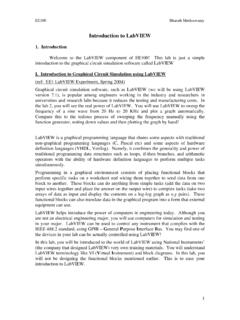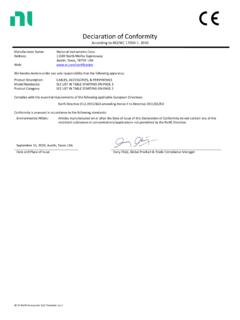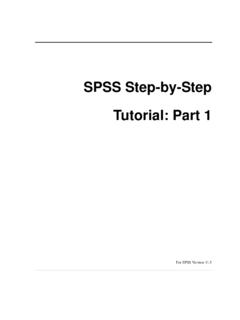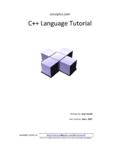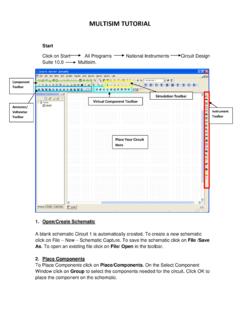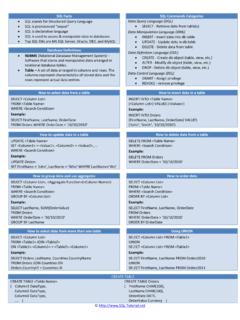Transcription of Controller Area Network (CAN) Tutorial - National …
1 National Instruments Corporation1-1 Controller Area Network (CAN) TutorialController Area Network (CAN) TutorialA Controller Area Network (CAN) bus is a high-integrity serial bus system for networking intelligent devices. CAN busses and devices are common components in automotive and industrial systems. Using a CAN interface device, you can write LabVIEW applications to communicate with a CAN csA. What You Need to Get StartedB. History of CANC. CAN BasicsD. Channel ConfigurationE. CAN APIsF. CAN Programming in LabVIEW (Channel API) Controller Area Network (CAN) What You Need to Get StartedTutorial MaterialsBefore you use this Tutorial , ensure you have all the following items: Windows 2000 or later installed on your computer. The Tutorial is optimized for Windows XP. Multifunction DAQ device configured as device 1 using Measurement & Automation Explorer (MAX) LabVIEW Full or Professional Development System 2009 or later A CAN Interface NI-CAN or later Exercises folder for saving VIs created during the Tutorial and for completing certain Tutorial exercises Solutions folder containing the solutions to all the Tutorial exercisesB.
2 History of CANIn the past few decades, the need for improvements in automotive technology caused increased usage of electronic control systems for functions such as engine timing, anti-lock brake systems, and distributorless ignition. Originally, point-to-point wiring systems connected electronic devices in vehicles. More and more electronics in vehicles resulted in bulky wire harnesses that were heavy and expensive. To eliminate point-to-point wiring, automotive manufacturers replaced dedicated wiring with in-vehicle networks, which reduced wiring cost, complexity, and weight. In 1985, Bosch developed the Controller Area Network (CAN), which has emerged as the standard in-vehicle Network . CAN provides a cheap, durable Network that allows the devices to speak through the Electronic Control Unit (ECU). CAN allows the ECU to have one CAN interface rather than analog inputs to every device in the system. This decreases overall cost and weight in automobiles. Each of the devices on the Network has a CAN Controller chip and is therefore intelligent.
3 All transmitted messages are seen by all devices on the Network . Each device can decide if the message is relevant or if it can be filtered. National Instruments Corporation1-3 Controller Area Network (CAN) TutorialAs CAN implementations increased in the automotive industry, CAN (high speed) was standardized internationally as ISO 11898. Later, low-speed CAN was introduced for car body electronics. Finally, single-wire CAN was introduced for some body and comfort devices. Major semiconductor manufacturers such as Intel, Motorola, and Philips developed CAN the mid-1990s, CAN was the basis of many industrial device networking protocols, including DeviceNet and ApplicationsExamples of CAN devices include engine Controller (ECU), transmission, ABS, lights, power windows, power steering, instrument panel, and so 1-1. Automotive CAN DevicesOther CAN MarketsComparing the requirements for automotive and industrial device networks showed the following similarities: the transition away from dedicated signal lines low cost resistance to harsh environments real-time capabilitiesThese similarities led to the use of CAN in industrial applications such as textile machinery, packaging machines, and production line equipment such as photoelectric sensors and its growing popularity in automotive and industrial applications, CAN has been increasingly used in a wide variety of applications.
4 Usage in systems such as agricultural equipment, nautical machinery, medical apparatus, semiconductor manufacturing equipment, avionics, and machine tools validate the versatility of PanelPower SteeringPower WindowsTransmissionLightsABSA utomotive CAN DevicesController Area Network (CAN) 1-2. Other CAN MarketsC. CAN BasicsBenefits of CAN Lower cost from reduced wiring compared to two wire, point-to-point wiring Highly robust protocol Built-in determinism Fault tolerance Reliable More than a decade of use in the automotive industryCAN Specifications CAN data (up to 8 bytes in a frame) Maximum 1 Mbaud/s 40 Meters at 1 Mbaud/s 6 km at 10 kbaud/s Theoretical maximum of 2,032 nodes per bus Practical limit is approximately 100 nodes due to transceiver Most buses use 3 10 nodes Data fields Arbitration ID (11 bit or 29 bit) Indicates message priorityTypes of CAN High Speed CAN Up to 1 M bits/s transmission rateCANP ublicTransportationAvionicsMilitarySyste msFarmMachineryOther Applications IncludingMedical DevicesPrinting Machines National Instruments Corporation1-5 Controller Area Network (CAN)
5 Tutorial Low Speed/Fault-Tolerant CAN Up to 125 kbaud/s transmission rate Fault tolerant Single Wire Up to kbaud/s High-voltage pulse to wakeup sleeping devicesNI CAN Interface DevicesNational Instruments provides four types of CAN interface devices that use the NI-CAN API described in this appendix. Each category of devices supports multiple form factors and is available in one or two port CAN 1 and 2 ports Maximum baud rate of 1Mb/sLow-speed CAN 1 and 2 ports Maximum baud rate of 125 kbaud/sSoftware Selectable CAN 1 and 2 ports (each port can be used as high-speed, low-speed, or single-wire CAN)Single Wire CAN 1 and 2 ports Maximum baud rate of kbaud/sCAN FrameCAN devices send data across the CAN Network on packets called frames. A typical CAN frame contains an arbitration ID, a data field, a remote frame, an error frame, and an overload Area Network (CAN) 1-3. Standard and Extended CAN FramesArbitration IDThe arbitration ID determines the priority of the messages on the bus.
6 If multiple nodes try to transmit a message onto the CAN bus at the same time, the node with the highest priority (lowest arbitration ID) automatically gets bus access. Nodes with a lower priority must wait until the bus becomes available before trying to transmit again. The waiting devices wait until the end of the frame section is 1-4. CAN ArbitrationData FieldThe data field contains the actual data being transmitted. The CAN protocol supports two data field formats as defined in the Bosch Version specifications, the essential difference being in the length of the arbitration ID. In the standard frame format (also known as ), the length of the ID is 11 bits. In the extended frame format (also known as ), the length of the ID is 29 NI-CAN terminology, a data field for which the individual fields are described is called a message. A message can contain one or more channels, Standard Frame FormatSOF11-BitArbitration IDRTRIDEDLC0 8 Data Bytes16-Bit CRCACKEnd of FrameSOFHigh 11-Bitsof Arbitration IDIDEDLC0 8 Data Bytes16-Bit CRCACKEnd of FrameLow 10-Bitsof Arbitration IDRTRE xtended Frame FormatDevice A transmitsID = 110 0100 0111 (647 hex)Device B transmitsID = 110 1100 0111 (6C7 hex)Device B loses and goes idle until end of frameDevice A wins, and proceeds1 10 010 0 01 1 11 10 1 National Instruments Corporation1-7 Controller Area Network (CAN) Tutorialwhich contain the data and other relevant information.
7 In Figure 1-5, the ABS message contains two channels Temperature and Area Network (CAN) 1-5. CAN Message with Two ChannelsD. Channel ConfigurationYou can configure Channels in MAX to enable LabVIEW to interpret your data fields. MAX allows you to load a set of channels from a database file or configure channels DatabasesTo translate the data field into usable data, a CAN device comes with a database that describes the channels contained in the message. A CAN Database File (CANdb File) is a text file that contains this information. It allows you to find the data in a frame and convert it to engineering units. For each channel, CAN databases store the following data:Channel nameLocation (Start bit) and size (number of bits) of the Channel within a given MessageByte Order (Intel/Motorola)Data type (signed, unsigned, and IEEE float)Scaling and units stringRangeDefault ValueCommentWith many software programs, you must manually convert the data field to usable data using the information contained in the database file.
8 However, using National Instruments software, this conversion is done for you. You can load the channel configuration from the file into MAX, and then use it in your application through the NI-CAN Overview:0123456771523317156142230614513 2129513412202841231119273112101826210191 725190816240876543210 CAN Data Frame0 x 85 TemperatureRPMs4 bytes2 bytesData Field (8 bytes)ArbitrationID National Instruments Corporation1-9 Controller Area Network (CAN) TutorialLoading Channels From a DatabaseTo import channel configurations from a Vector CANdb file into MAX, right-click the CAN Channels heading and select Import from CANdb File. <Shift>-click to select multiple channels, then select Import. If you need to select another set, you can select the channels and then import them again. When you finish importing, click Done to return to also can access a CAN database directly from the LabVIEW CAN API. However, loading the channels into MAX prevents you from having to specify a path in your LabVIEW programs and allows you to read and write from the channels using the MAX test 1-6.
9 Importing a CAN Database File In MAXE xplicitly Creating a ChannelIf no database file exists, you can create channels in MAX. Complete the following steps to create channels within MAX: 1. Right-click the CAN Channels heading under Data Neighborhood and select Create Message. 2. Enter the message properties and click OK. After the message is created, it appears under CAN Channels. 3. Right-click the message name and select Create Channel. A configuration box appears similar to the one shown in Figure 1-7. As you enter information about Start Bit and No. of Bits, the matrix is populated with dimmed boxes to indicate the bits that have already been Controller Area Network (CAN) in channel definitions for that message. Blue boxes indicate the bits that are currently being 1-7. Explicit Channel Configuration in MAX4. Enter the channel properties and click the OKbutton. 5. Right-click and select Create Channel again for each channel contained in the message.
10 6. To save channel configurations to a file, right-click the CAN Channels heading and select Save Channel Configuration. Saving the channel configuration creates a custom database file for your device. The resulting NI-CAN database file uses file extension .ncd. You can access the NI-CAN database just like any other CAN database. By installing the NI-CAN database file along with your application, you can deploy your application to a variety of can also test explicitly created channels using the Channel Test CAN APIsThere are two APIs that you can use with NI-CAN hardware: Channel and Frame. Channel API High level National Instruments Corporation1-11 Controller Area Network (CAN) Tutorial Easy-to-use physical units Easy CAN/DAQ synchronization Not compatible with NI-CAN or lower Frame API Lower-level, advanced API Command/response protocol Advanced CAN/DAQ synchronization Compatible with all versions of NI-CANFor a single NI-CAN port such as CAN0, you can use only one API at a time.



